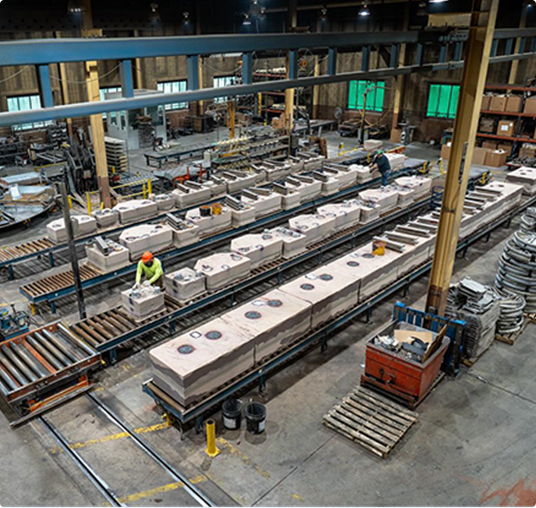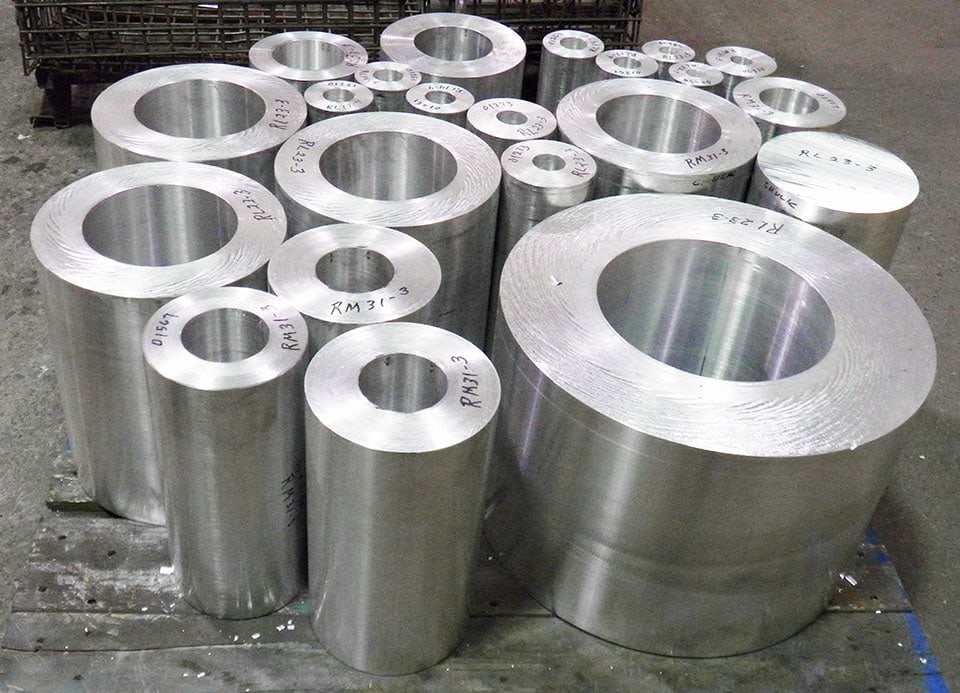Discovering the Versatile Uses and Applications of Aluminum Castings in Modern Industries
Light weight aluminum spreadings have ended up being important to various contemporary sectors as a result of their special residential properties. They supply considerable benefits in weight reduction, thermal conductivity, and corrosion resistance. From automobile innovations to applications in durable goods and building, their convenience is exceptional. Yet, truth degree of their influence expands past immediate advantages, hinting at broader implications for sustainability and performance. What lies in advance for light weight aluminum castings in an ever-evolving industrial landscape?
Automotive Market Innovations
The vehicle sector has progressively accepted aluminum spreadings to boost lorry efficiency and performance. By utilizing aluminum, suppliers can produce lighter elements, which add to enhanced fuel economic situation and reduced exhausts. Trick applications consist of engine blocks, transmission situations, and structural components, where the product's strength-to-weight ratio delivers toughness without including excess weight.
Light weight aluminum spreadings also use superior thermal conductivity, which helps in far better warmth dissipation, thereby enhancing engine efficiency. Additionally, innovations in casting modern technologies, such as die spreading and sand spreading, allow the manufacturing of complex geometries, enabling ingenious layouts that optimize area and performance.
The recyclability of light weight aluminum straightens with sustainability goals in the automobile field, promoting environmentally friendly methods. As the industry remains to introduce, using light weight aluminum castings is most likely to increase, driving further developments in vehicle layout and efficiency.
Aerospace Applications and Developments
While the aerospace sector continues to prioritize weight reduction and fuel effectiveness, aluminum castings have arised as a crucial material choice for numerous applications. Their lightweight nature, coupled with high strength-to-weight proportions, permits considerable renovations in airplane performance and efficiency. Aluminum castings are frequently made use of in architectural components, such as fuselage frames and wing components, where minimizing weight is essential.
Current developments in light weight aluminum spreading modern technologies, including boosted alloy formulas and accuracy spreading methods, have further enhanced the material's performance capacities. These innovations enable the production of intricate geometries and intricate designs while maintaining structural honesty. Additionally, light weight aluminum's superb rust resistance warranties durability and reliability in rough aerospace environments.
As the aerospace industry progressively accepts sustainability, light weight aluminum castings supply a recyclable remedy that lines up with eco-friendly practices, making them a crucial aspect in the advancement of next-generation airplane.
Durable Goods and Everyday Products
As customers increasingly look for light-weight yet durable materials for daily items, light weight aluminum spreadings have gained appeal in numerous consumer goods. The unique buildings of aluminum, including its resistance to deterioration and exceptional thermal conductivity, make it an excellent option for products like pots and pans, home appliances, and outdoor equipment. Aluminum cast pans and pots provide also heat circulation, enhancing cooking effectiveness. In addition, using light weight aluminum in things such as bicycle frameworks and travel luggage ensures a balance between strength and portability. Suppliers value light weight aluminum castings for their convenience, as they can be quickly molded right into intricate forms while maintaining architectural integrity. The ability to recycle light weight aluminum without degrading its homes aligns with growing consumer choices for lasting products. On the whole, light weight aluminum castings are essential to the manufacturing of durable, functional, and aesthetically pleasing durable goods, meeting the demands of modern-day lifestyles.
Construction and Architectural Makes Use Of
Aluminum castings have ended up being a necessary element in construction and architectural design, particularly due to their stamina and lightweight nature. These residential properties make aluminum an excellent choice for different applications, including architectural elements, exteriors, and attractive attributes - Aluminum Foundry. Home builders and engineers progressively make use of aluminum spreadings for window structures, doors, and roof systems, boosting both functionality and visual appeals. The product's resistance to rust additionally prolongs its life-span, decreasing upkeep costs and making certain durability in varied environmental conditions
Aluminum can be quickly molded right into elaborate designs, enabling for ingenious architectural expressions. Its convenience helps with the development of custom pieces that satisfy particular layout needs, from elaborate barriers to intricate assistances. As sustainability becomes a concern, light weight aluminum's recyclability includes in its allure in eco-friendly construction methods. Generally, light weight aluminum castings are transforming the construction industry by supplying light-weight, durable, and visually enticing solutions.
Digital and electric Parts
Aluminum castings play a necessary function in the production of lightweight electrical units, which enhance mobility and efficiency in various applications. In enhancement, their outstanding thermal conductivity makes them optimal for warmth sinks, guaranteeing peak efficiency and longevity of digital components. Light weight aluminum's conductive buildings add to its use in various electric conductors, stressing its relevance in modern-day innovation.
Light-weight Electrical Units
Lightweight electrical enclosures play a vital duty in shielding sensitive electronic elements from ecological elements and physical damages. Created from light weight aluminum spreadings, these units are valued for their strength-to-weight ratio, making them excellent for different applications throughout industries. Their lightweight nature aids in reducing general system weight, which is important in mobile and mobile electronic devices. Aluminum's rust resistance enhances toughness, extending the lifespan of the enclosed elements. The ability to mold and mildew aluminum right into intricate forms enables for customized styles, accommodating certain needs while ensuring efficient warmth dissipation. Additionally, these enclosures can be easily integrated into existing systems, providing adaptability and versatility in modern-day technological atmospheres. Overall, light-weight light weight aluminum units considerably add to the efficiency of digital devices.
Heat Sinks and Conductors
While many materials are utilized in electronic components, light weight aluminum castings attract attention for their effectiveness in warm administration as warmth sinks and conductors. Their outstanding thermal conductivity permits for efficient heat dissipation, which is vital in avoiding the getting too hot of digital gadgets. Light weight aluminum's lightweight nature better enhances its suitability for applications where weight is a considerable factor, such as in aerospace and automotive industries. In addition, light weight aluminum castings can be easily built into complex forms, offering design adaptability for maximizing thermal efficiency. The rust resistance of light weight aluminum also adds to the long life and dependability of these components in different atmospheres. As modern technology advances and devices become extra small, the demand for effective heat administration solutions, like aluminum spreadings, remains to expand.
Marine Sector Use
The aquatic industry increasingly relies upon light weight aluminum castings for their phenomenal sturdiness and corrosion resistance. These residential properties make aluminum a perfect choice for different applications, consisting of watercraft hulls, engine components, go to this site and aquatic equipment. The light-weight nature of aluminum castings makes it possible for improved fuel efficiency and easier maneuverability in watercraft, which is essential for both industrial and entertainment vessels.

Aluminum spreadings additionally give significant price advantages because of their lengthy life-span and reduced upkeep requirements, minimizing the total operational expenses for marine operators. Additionally, the flexibility of aluminum enables for complex designs that can satisfy certain performance requirements.
Suppliers in the marine market utilize innovative spreading strategies to create complicated shapes, ensuring that elements meet strenuous safety and efficiency standards. As the need for high-performance marine vessels expands, light weight aluminum spreadings are positioned as a crucial product in improving the capability and longevity of aquatic tools.
Sustainability and Recycling in Aluminum Spreading

Aluminum Recycling Process
Recycling light weight aluminum plays a vital function in decreasing ecological influence and preserving sources within the casting market. The aluminum recycling process begins with the collection of scrap aluminum, which can include old components, manufacturing waste, and post-consumer products. This scrap is then sorted, cleaned, and shredded right into little items to assist in melting.
Once prepared, the light weight aluminum scrap is melted in a furnace at lower temperatures than primary aluminum production, substantially reducing power intake. The liquified aluminum is then cast right into ingots or various other forms for reuse in various applications - Metal Castings. This closed-loop system permits for the effective healing of aluminum, preserving its residential properties while minimizing the requirement for virgin materials. The reusing procedure is a critical part of lasting methods in light weight aluminum spreading.
Environmental Advantages
While light weight aluminum spreading plays a crucial function in numerous sectors, its environmental advantages are especially remarkable pertaining to sustainability and resource conservation. The light-weight nature of aluminum contributes to energy effectiveness in transport, reducing gas usage and emissions. Furthermore, light weight aluminum spreading helps with making use of recycled materials, significantly decreasing the power required for manufacturing contrasted to main light weight aluminum. This reusing procedure reduces waste and lessens the ecological influence related to mining and refining resources. Furthermore, light weight aluminum is 100% recyclable without deterioration of its residential or commercial properties, promoting a sustainable lifecycle. By choosing light weight aluminum casting, industries can substantially reduce their carbon impact while promoting source efficiency, making it an essential selection in the pursuit of eco-friendly production techniques.
Closed-Loop Equipments

Regularly Asked Questions
What Are the Trick Conveniences of Light Weight Aluminum Castings Over Other Materials?
Aluminum spreadings use light-weight residential or commercial properties, exceptional deterioration resistance, and high strength-to-weight ratios. They can be easily built into complex shapes, give excellent thermal and electric conductivity, and are cost-efficient, making them better over lots of alternate materials.
Exactly how Is the Aluminum Casting Process Environmentally Pleasant?
The aluminum casting procedure is environmentally pleasant as a result of its recyclability, reduced energy usage, and minimized waste production. Its capability to use recycled products decreases the carbon impact, advertising sustainability within making practices.
What Are Common Challenges in Aluminum Casting Production?
Common obstacles in light weight aluminum spreading production include keeping dimensional precision, taking care of thermal tightening, avoiding flaws like porosity and incorporations, ensuring proper mold design, and optimizing manufacturing performance while minimizing material waste and environmental effect.
How Do Light Weight Aluminum Castings Compare in Price With Other Production Techniques?
Light weight aluminum spreadings generally use competitive expenses contrasted to other producing techniques, especially for tool to high-volume production. Their reduced preliminary tooling expenditures and reliable try this material usage can cause positive business economics with time.
What Future Fads Are Anticipated in Light Weight Aluminum Casting Modern Technology?
Future trends in aluminum casting technology are prepared for to include developments in automation, improved alloy make-ups, improved reusing methods, and the integration of 3D printing, all targeted at enhancing performance, reducing costs, and reducing environmental impact.
Recent developments in light weight aluminum spreading modern technologies, consisting of boosted alloy formulations and accuracy casting techniques, have actually better enhanced the product's efficiency capacities. Light weight aluminum castings have become a necessary part in construction and building style, particularly due to their strength and light-weight nature. The light weight aluminum recycling process starts with the collection of scrap light weight aluminum, which can consist of old parts, producing waste, and post-consumer products. Once prepared, the light weight aluminum scrap is thawed in a heating system at lower temperatures than main light weight aluminum production, substantially decreasing power usage. Furthermore, light weight aluminum spreading facilitates the usage of recycled materials, considerably decreasing the power required for manufacturing compared to primary aluminum.